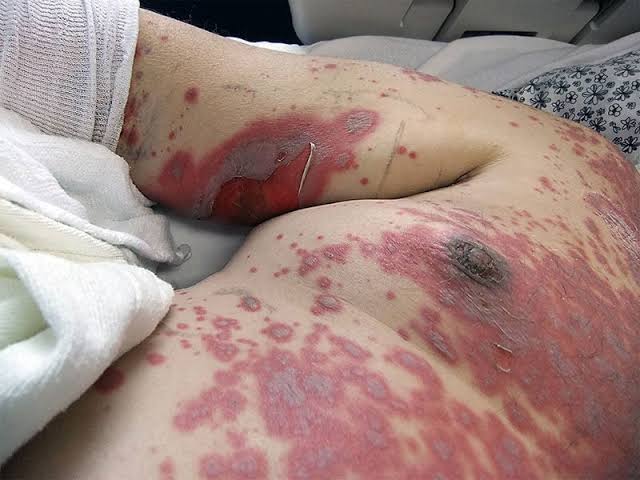Foods to Avoid if You Have Vitiligo;
Living with vitiligo can be challenging, but managing your diet can help alleviate symptoms and promote overall well-being. Certain foods can exacerbate inflammation or interfere with melanin production, worsening the condition.
Here’s a comprehensive guide on foods to avoid if you have vitiligo:
1. Dairy Products
Dairy products may contain high levels of arachidonic acid, which can trigger inflammation in the body, potentially aggravating vitiligo.
Dairy Products to Avoid in Vitiligo
1. Dairy’s Impact: Dairy products contain a precursor molecule of all inflammatory mediators – arachidonic acid, known to trigger inflammation in the body.
2. Specific Dairy to Skip:
- Milk, especially cow’s milk
- Cheese, especially hard cheeses like cheddar and Parmesan
- Yogurt, which may still contain arachidonic acid despite its probiotic benefits
3. Risks Involved: Dairy consumption can worsen inflammation and oxidative stress, potentially worsening vitiligo symptoms and promoting depigmentation.
4. Better Alternatives:
- Opt for plant-based milks such as almond, coconut, or oat milk for a creamy texture without the inflammatory effects.
- Nutritional yeast can add a cheesy flavor to dishes without aggravating vitiligo symptoms.
- Explore non-dairy yogurts made from coconut, almond, cashews, or soy as probiotic-rich alternatives to traditional yogurt.
2. Processed Foods
1. Why to avoid Processed Foods?
Processed foods are typically high in additives, preservatives, and artificial flavors, which can disrupt the body’s natural processes and exacerbate inflammation.
2. Specific Processed Foods to Skip:
- Packaged snacks like chips, crackers, and cookies
- Frozen meals and convenience foods
- Sugary beverages and sodas
- Processed meats such as deli meats, sausages, and bacon
3. Risks Involved:
Consuming processed foods can contribute to inflammation and oxidative stress, potentially worsening vitiligo symptoms and promoting depigmentation.
4. Better Alternatives:
- Opt for whole, unprocessed foods such as fruits, vegetables, nuts, seeds, lean proteins, and whole grains.
- Choose homemade meals prepared with fresh, natural ingredients to minimize exposure to additives and preservatives.
3. Red Meat
Red meat, particularly beef and lamb, contains high levels of saturated fats, which can increase inflammation and oxidative stress in the body, potentially worsening vitiligo symptoms.
4. Gluten
1. Why to avoid Gluten?
Gluten is a protein found in wheat, barley, rye, and their derivatives, known to trigger autoimmune reactions in some individuals.
2. Specific Gluten Sources to Skip:
- Wheat-based products such as bread, pasta, and baked goods
- Barley and rye-based products like beer, malt, and certain cereals
3. Risks Involved:
Gluten consumption can provoke autoimmune responses, leading to inflammation and potentially exacerbating vitiligo symptoms.
4. Better Alternatives:
- Opt for gluten-free grains such as rice, quinoa, buckwheat, and millet.
- Explore gluten-free flour alternatives like almond flour, coconut flour, or chickpea flour for baking needs.
5. Nightshade Vegetables
1. Why to avoid Nightshade Vegetables?
Nightshade vegetables belong to the Solanaceae family and contain compounds like solanine, which may trigger inflammation in some individuals.
2. Specific Nightshade Vegetables to Skip:
- Tomatoes
- Peppers (bell peppers, chili peppers)
- Eggplants
3. Risks Involved:
Nightshade vegetables can potentially exacerbate inflammation and oxidative stress, worsening vitiligo symptoms and promoting depigmentation.
4. Better Alternatives:
- Opt for non-nightshade vegetables such as leafy greens, carrots, cucumbers, and squash.
- Explore a variety of colorful vegetables to maximize antioxidant intake and support skin health.
6. Shellfish
Shellfish like shrimp, crab, and lobster can contain high levels of iodine, which may interfere with thyroid function and exacerbate autoimmune conditions like vitiligo.
7. Citrus Fruits
Citrus fruits like oranges, lemons, and grapefruits contain psoralens, compounds that can make the skin more sensitive to sunlight and potentially worsen vitiligo symptoms when consumed in excess.
8. Coffee
Coffee contains caffeine, which can stimulate the production of cortisol, a stress hormone that may trigger autoimmune reactions and exacerbate inflammation in individuals with vitiligo.
9. Artificial Sweeteners
Artificial sweeteners like aspartame and sucralose can disrupt gut health and may trigger inflammatory responses in some individuals, potentially worsening vitiligo symptoms.
10. Alcohol
Alcohol consumption can impair liver function and weaken the immune system, making it harder for the body to fight inflammation and oxidative stress, which can worsen vitiligo symptoms.
Conclusion
While there is no definitive cure for vitiligo, managing your diet can play a significant role in alleviating symptoms and promoting overall well-being. By avoiding foods that can trigger inflammation or interfere with melanin production, individuals with vitiligo can potentially improve their quality of life and minimize the progression of the condition.
Frequently Asked Questions (FAQs) on Foods to Avoid in Vitiligo
1. Which food is good for vitiligo?
- Foods rich in antioxidants, vitamins, and minerals such as fruits, vegetables, nuts, seeds, and whole grains are beneficial for vitiligo patients. Incorporate colorful fruits and vegetables into your diet to boost antioxidant intake.
2. What should I avoid if I have vitiligo?
- Avoid foods that can trigger inflammation or interfere with melanin production, such as dairy products, processed foods, red meat, gluten, and shellfish.
3. Is egg good for vitiligo?
- Eggs are a good source of protein and essential nutrients but may contain arachidonic acid, which can trigger inflammation in some individuals. It’s best to consume eggs in moderation and monitor how your body responds.
4. Can we eat curd in vitiligo?
- Curd, or yogurt, may contain high levels of arachidonic acid, which can exacerbate inflammation and potentially worsen vitiligo symptoms. Consider opting for non-dairy alternatives such as almond or coconut yogurt.
5. Can I eat ghee in vitiligo?
- Ghee, or clarified butter, is a dairy product that may contain high levels of arachidonic acid. It’s best to avoid ghee if you have vitiligo and opt for plant-based oils such as olive oil or coconut oil instead.
6. How to stop spreading vitiligo?
- While there is no guaranteed way to stop vitiligo from spreading, managing stress levels, protecting the skin from sun exposure, and following a healthy diet rich in antioxidants can help minimize the progression of the condition.
7. Which fruit is good for vitiligo?
- Fruits such as berries, citrus fruits, and tropical fruits like papaya and pineapple are rich in antioxidants and vitamins that can help support skin health and may benefit individuals with vitiligo.
8. How can I clear my vitiligo?
- Clearing vitiligo completely is challenging, but treatments such as phototherapy, topical steroids, and depigmentation therapy may help reduce the appearance of white patches and promote repigmentation. Consult a dermatologist for personalized treatment options.
9. Can we eat mango in vitiligo?
- Mangoes are a rich source of vitamins and antioxidants but contain psoralens, compounds that can make the skin more sensitive to sunlight. Individuals with vitiligo should consume mangoes in moderation and protect their skin from sun exposure.
10. What foods trigger vitiligo?
– Foods high in arachidonic acid, gluten, iodine, and artificial additives may trigger inflammation and oxidative stress, potentially worsening vitiligo symptoms.
11. What increases vitiligo?
– Factors such as stress, genetics, autoimmune disorders, and environmental triggers can contribute to the development and progression of vitiligo.
12. Can we drink tea in vitiligo?
– Green tea, in moderation, can be beneficial for individuals with vitiligo due to its antioxidant properties. However, black tea and caffeinated teas may contain compounds that can trigger inflammation and should be consumed in moderation.
13. Can I eat honey in vitiligo?
– Honey is a natural sweetener with potential anti-inflammatory and antioxidant properties. While more research is needed, consuming honey in moderation as part of a balanced diet may be beneficial for individuals with vitiligo.
14. Does vitiligo go away?
– Vitiligo is a chronic skin condition characterized by depigmented patches that may spread over time. While there is no cure for vitiligo, various treatments can help manage symptoms and promote repigmentation in some cases. It’s essential to consult a dermatologist for proper diagnosis and treatment recommendations.
Read More:

